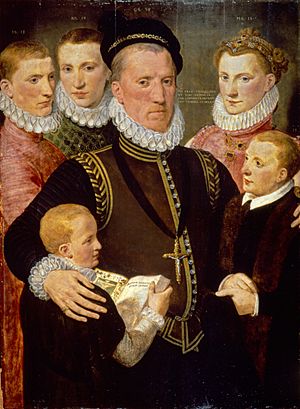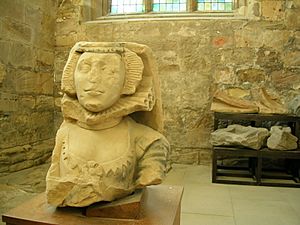William Seton of Kylesmure facts for kids
William Seton of Kylesmure (born 1562, died 1635) was an important Scottish gentleman. He owned land and held several key jobs. He was a postmaster, the main law officer (Sheriff) for Edinburgh, and he managed lands for Anne of Denmark, who was the Queen of Scotland and England.

William was the son of George Seton, 7th Lord Seton and Isobel Hamilton. He lived in a town called Haddington, East Lothian.
Contents
Helping Bring Peace to the Borders
In 1605, William Seton was chosen for a special group. This group's job was to help bring peace to the Scottish borders. This area was often wild and lawless. The group was formed after Scotland and England joined under one king.
William was likely chosen because his brother, Alexander Seton, 1st Earl of Dunfermline, had just become the top legal official in Scotland. Other members of the group were already well-known in the border areas.
Family Matters and Titles
William Seton often helped his family with important legal issues.
In 1606, his nephew, Robert Seton, 2nd Earl of Winton, gave up his title as Earl. This was because he was unable to manage it. The title then went to Robert's younger brother, George Seton, 3rd Earl of Winton. William Seton was involved in all the legal steps needed for this change. He acted as an uncle and advisor to Robert.
In 1612, William also gave advice to Anne Livingstone. She used to be a lady-in-waiting to Queen Anne. Anne Livingstone had married William's nephew, Alexander Seton of Foulstruther. They hoped Alexander would become the Earl of Eglinton.
William Seton wrote to Anne Livingstone. He told her to write to an important court lady, Lady Jane Drummond, and to Queen Anne herself. He advised her to ask them to speak to King James. She should remind them that she had served Princess Elizabeth since she was a baby, and later Queen Anne. William wanted them to tell the King that Queen Anne knew and approved of her marriage plans. But this was only if Alexander Seton of Foulstruther could become the Earl of Eglinton.
William Seton spoke to the Scottish government (Privy Council of Scotland) in 1613 for his nephew. They talked about the complicated process of changing family names for titles. The Council looked at the documents but said only a higher court could decide. Finally, in 1615, Alexander Seton was officially made Earl of Eglinton. This happened because King James sent instructions through John Murray.
Sheriff and Postmaster Roles

As the Sheriff of Edinburgh, William Seton was in charge of justice. In 1616, he held a court in Peebles. Many cases were heard. After the court, he wrote to the King's lawyer, Lord Binning. He expressed sadness that some people who could have been useful were no longer able to serve.
In 1616, William bought a large house and some empty land in Dunfermline. He later gave this property to his brother, the Earl of Dunfermline, in 1619.
In April 1617, Queen Anne made new choices for the people who advised her on her Scottish lands. William Seton of Kylesmure was chosen to be one of her counsellors.
In 1619, as the Postmaster, he called together other postmasters. They met to discuss problems with mail delivery to England. In July 1619, the Chancellor reminded King James that William Seton was excused from serving as a local judge for Haddingtonshire.
William Seton passed away in 1635. He was buried at Seton Collegiate Church.
Family Life
William Seton married Agnes Sinclair, also known as Agnes Stirling. She was the daughter of Stirling of Glorat. They had several children:
- William Seton
- John Seton, who became a soldier in France. He served in a Scottish army group led by Colonel Hepburn.
- A daughter who married John Auchmoutie in 1616. Anne Livingstone, Countess of Eglinton was a guest at their wedding.

